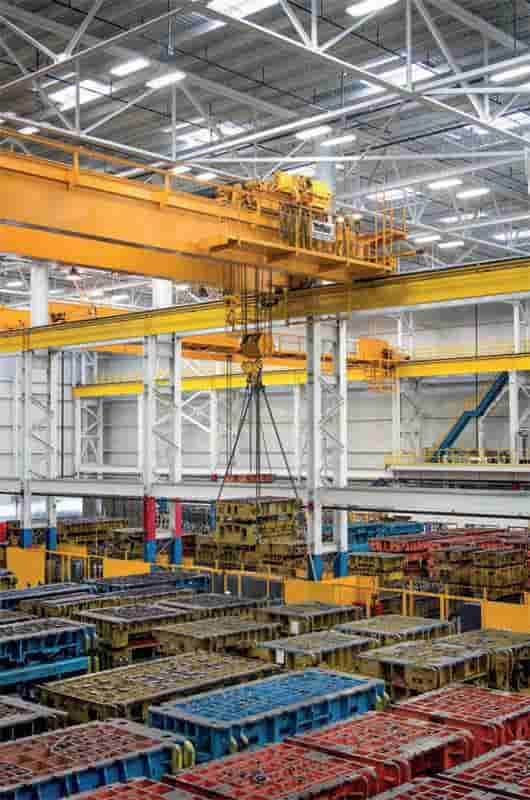Heavy lifting hoists and overhead cranes are more than just scaled-up versions of smaller systems. Julian Champkin investigates.

Overhead hoists and bridge cranes come in all sizes, from workstation hoists lifting 250kg up to doublegantry cranes that can lift 200t or more. From 5–10t and upwards, hoists can reasonably be considered to be doing heavy lifting. The US Class D classification covers many such cranes. Typical uses are in heavy machine shops, foundries, fabricating plants, steel warehouses, lumber mills, and in bucket and magnet operations where heavy-duty production is required.
Is a big hoist such as a Class D simply a scaled-up version of a smaller hoist? Or do other considerations apply? “If we are talking about higher-capacity cranes based on weight alone, they are somewhat scalable,” says Brian Weidenhammer, engineering manager of South Carolina-based company Engineered Systems. “The size of the bridge girder is a function of the weight of the load and the span of the crane. However, if we are talking about the work capacity of the crane in a Class D situation, the crane has to handle higher duty cycles and possibly a higher percentage of at-capacity lifts. In these cases, component producers like Ingersoll Rand will have to provide higher-duty mechanical and electrical components.”
Mark Koski is North American commercial leader at Ingersoll Rand who, as Weidenhammer says, supply components to heavy-lift crane makers. “We call them our innovators,” he says. Heavier loads are part of his world. “A single-girder design can serve capacities of up to around 25t. If you are lifting more than that, a top-running double-girder or a box-girder is more suitable.”
But moving from one girder to two instantly involves a complexity leap: “And therefore it also involves an expenditure leap. There is a major price jump, easily two-fold, as soon as you look at two girders. So my advice to clients is if you are on a budget, and if you realistically can, then limit your lifting to 25t and save yourself money.
“And the other piece of advice I would give to a company wanting to install heavy lifting would be ‘Talk to your architect ahead of time.’ The reason boils down to headroom, because headroom is expensive. We get calls to put a hoist on a beam, and it is so much easier to mount the trolley to run on top of the beam. Of course we can supply lowand ultra-low-headroom units in all the power sources we offer—pneumatic, hydraulic or electric; but again, they cost more. It could well be cheaper to go for a standard-headroom hoist and raise the height of your roof to give it clearance! A heavy load such as a turbine may have to be placed in exactly the right position, down to the millimetre. “Speeds in heavy lifting are much slower. But a characteristic is that positioning is much more precise,” says Koski. “So you have variable speeds, with sensitive control and spotting visibility. It is not about automation; if you are lifting a generator worth a million dollars you want the skill of the operator and you want controls that let him the feel of his crane. You do though want remote control, because the operator standing under the load is a very bad idea.”
Demand is steady and increasing, he says. “The focus in this market is on customisation. Oil and gas are among the industries that need high capacities. Turbine halls need large-capacity cranes for maintenance. Those can be typical users.”
One of his innovators is Canadian company Hoisting Ltd. Andrew Phelan is their vice president, sales. “We are based in Alberta, outside Edmonton,” he says. “Heavy oil-sands extraction has been a major customer for us but we are gradually shifting our focus, still in the resource sector but towards products such as Liquefied Natural Gas. A massive LNG terminal is being built on Canada’s west coast to feed the Asian market, and companies like Petronas are using our services.”
He agrees with Koski that the client’s needs are paramount. “Lifting gear of these capacities are almost entirely custom-built, for that particular client’s needs. The first thing you need is a good understanding of the application. Here in Canada it might involve cold weather ambient environment, and any corrosive or explosive atmosphere and so on are only part of it. “Frequency of lift is important: is it a crane to be used once every few months for maintenance, or is it in continuous daily operation? Also important is the lifetime expectation: is the client expecting his project to be over in five years’ time from now, or is he looking for 50 years of service from the crane?”
And, like Koski, he says there is a quantum jump at around 25t: “In design considerations, 25t capacity is the turning the usual solution; above it you turn to box girder designs. There is little flexibility in an I-beam. All you can do is make it bigger, and over a certain size you would end up with it so heavy that you would need massive support structures underneath it. With a box girder design the fabrication costs will be more but it will take less material to construct it, which helps compensate for that.” “Single girder systems do have a limit in terms of capacity, span, and hook height,” says Mike Close, content manager of the Mazella group. “You will rarely see a single girder crane rated higher than 15t. With a double girder design, you gain the depth of the cross girder if the hoist is placed between or on top of the cross girders—providing an extra 18–36 inches (450–900mm) of hook height in most complex in design, making the doublegirder a more expensive option.”
Heavy lifting hoists and overhead cranes are more than just scaled-up versions of smaller systems
没有评论:
发表评论